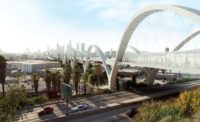Display of the Retired Space Shuttle: An Opportunity Los Angeles Should Not Miss


Last year, the National Aeronautics and Space Administration selected four sites to permanently display a space-shuttle orbiter, and the California Science Center in Los Angeles will house the Endeavour. As an aerospace engineer, architect and believer in the modernist tradition, I have some suggestions for the exhibit.
The plans so far call for exhibiting the orbiter both horizontally and, later, vertically, as if it were ready for launch. But I have another concept: Dock the Endeavour to a full-scale mock-up of the International Space Station. The result would resemble a theme park—an idea that already has been suggested for the Endeavour's arrival and parade through town.
I had the good fortune to be part of the design teams for both the shuttle and the space station. I was privileged to view a landing of the space shuttle Columbia at Edwards Air Force Base and witnessed the great drama of waiting for the shuttle and the astronauts to readjust to Earth before opening the hatch.
To exhibit the shuttle with the full-scale mock-up of the space station would require the area of a football field, but it would promote peace and humanity instead of conflict and competition. An exhibit that includes both shuttle and space station would become a never-ending draw for visitors.
These important machines would also promote science, technology, engineering and mathematics like nothing else. And Southern California, where the major components of these machines were created, truly deserves to show them off. Such an exhibit could be tantamount to a world's fair exhibit. For a city that specializes in simulations, this type of exhibit could become a movie set like no other.
The biggest design challenge is how to configure the orbiter.
Landing v. Docking
Launch configuration is more suited to the Kennedy Space Center exhibit, where launches occurred and where the launch structures exist. But landings have been made in California, and a landing configuration would be more appropriate in Los Angeles' exhibit. A mock-up of the International Space Station already exists for astronaut training in Houston. Perhaps the landing mode and the docking mode could both be combined by the deft use of simulation techniques?
There are other design challenges. Endeavour itself is to be preserved untouched and therefore could be enclosed in a transparent envelope. The technology for this envelope would be a challenge, but augmented reality could be a solution (it is already being used in England at the Museum of London). Simulated scenarios could be presented as overlays or as almost X-ray views of the interior.
Materials technology has advanced to the point where the air and space center exhibit could be made entirely of structural glass with state-of-the-art environmental controls. Perhaps the exhibit could be made large enough to exhibit the actual International Space Station if it can somehow be retrieved from space.
If we use our imaginations, a tantalizing but realizable design is possible—two equal-sized domes on the spacious South Lawn of Los Angeles' Exposition Park. One would be a spacecraft dome housing Endeavour and the International Space Station. A second would be for the museum's aircraft, suspended in flight, or grounded.
If ever there was a need for a strict Bauhaus-style, Miesian and non-idolatrous approach to architecture, it is now. Although I was born in the Jazz Age, I don't like the dissonance in jazz or in architectural design. Too often, architects are banding together to manage technology. But that's the engineers' role! Let engineers become architects as did Frank Lloyd Wright, and as I did, and let architects become engineers. And let's have an exhibit worthy of space exploration and Los Angeles.
Los Angeles-based Theodore H. Nathanson is an aerospace engineer and registered architect in Quebec. The designer of numerous structures, he can be reached at 213-590-6926.
I like the idea. However is there any evidence let alone hard evidence that such a display would <br/>actually deliver on the enumerated benefits.<br/><br/>Engineering needs to be made ...
actually deliver on the enumerated benefits.
Engineering needs to be made more attractive if the desire is to get more United States youth interested and not by showmanship however well intentioned.
"Take off your engineering hat and put on your management hat" is negatively inspiring too.





